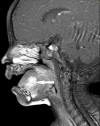Case report: Clinical features and prognosis of two Infants with rhabdomyosarcoma of the tongue
- PMID: 36686750
- PMCID: PMC9846346
- DOI: 10.3389/fonc.2022.934882
Case report: Clinical features and prognosis of two Infants with rhabdomyosarcoma of the tongue
Abstract
Background: Rhabdomyosarcoma (RMS) is the most common soft tissue tumor in children, and its most common pathological types include embryonal RMS and alveolar RMS. In contrast, spindle cell RMS (SRMS) is a rare type. Moreover, the tongue is a rare primary site of RMS, and infancy is a rare age at onset.
Case presentation: Two infants were diagnosed with lingual RMS at 3 and 5 months after birth, respectively, and were admitted to Beijing Children's Hospital. The pathological type in both cases was SRMS. Both were classified as low-risk and were treated with surgery and chemotherapy. Case 1 was in complete remission at the latest follow-up, and Case 2 had a relapse 10 months after stopping chemotherapy, achieving complete remission after the multimodal treatment of chemotherapy, surgery, and radiotherapy. The venous blood gene test of the two infants did not indicate a pathogenic mutation or a possible pathogenic mutation related to RMS. In Case 1, variants of the CDK4 and BRCA1 genes, both with unknown significance and a possible relation to RMS, were detected. In Case 2, three gene variants of unknown significance that were possibly associated with RMS-TRIP13, APC, and RAD54L-were identified.
Conclusion: Lingual RMS in infants is rare. Its clinical manifestations lack specificity, and early recognition is complex. The success and timing of local treatment are important prognostic factors. Genetic testing may be helpful for the early detection of tumor susceptibility and the estimation of prognosis.
Keywords: case report; infant; spindle cell rhabdomyosarcoma; susceptibility gene; tongue.
Copyright © 2023 Yang, Xu, Su, Duan, Wang, Fu, Yu, Guo and Ma.
Conflict of interest statement
The authors declare that the research was conducted in the absence of any commercial or financial relationships that could be construed as a potential conflict of interest.
Figures
Similar articles
-
[Clinical and prognostic analysis of single-center multidisciplinary treatment for rhabdomyosarcoma in children].Zhonghua Er Ke Za Zhi. 2019 Oct 2;57(10):767-773. doi: 10.3760/cma.j.issn.0578-1310.2019.10.008. Zhonghua Er Ke Za Zhi. 2019. PMID: 31594063 Chinese.
-
Congenital spindle cell rhabdomyosarcoma: An international cooperative analysis.Eur J Cancer. 2022 Jun;168:56-64. doi: 10.1016/j.ejca.2022.03.022. Epub 2022 Apr 19. Eur J Cancer. 2022. PMID: 35452896 Free PMC article.
-
Integrative clinical and biopathology analyses to understand the clinical heterogeneity of infantile rhabdomyosarcoma: A report from the French MMT committee.Cancer Med. 2020 Apr;9(8):2698-2709. doi: 10.1002/cam4.2713. Epub 2020 Feb 22. Cancer Med. 2020. PMID: 32087612 Free PMC article.
-
Molecular testing of rhabdomyosarcoma in clinical trials to improve risk stratification and outcome: A consensus view from European paediatric Soft tissue sarcoma Study Group, Children's Oncology Group and Cooperative Weichteilsarkom-Studiengruppe.Eur J Cancer. 2022 Sep;172:367-386. doi: 10.1016/j.ejca.2022.05.036. Epub 2022 Jul 12. Eur J Cancer. 2022. PMID: 35839732 Review.
-
Orofacial rhabdomyosarcoma in neonates and young children: a review of literature and management of four cases.Oral Oncol. 2002 Jul;38(5):508-15. doi: 10.1016/s1368-8375(01)00087-2. Oral Oncol. 2002. PMID: 12110348 Review.
Cited by
-
Tongue orthotopic xenografts to study fusion-negative rhabdomyosarcoma invasion and metastasis in live animals.Cell Rep Methods. 2024 Jul 15;4(7):100802. doi: 10.1016/j.crmeth.2024.100802. Epub 2024 Jul 3. Cell Rep Methods. 2024. PMID: 38964316 Free PMC article.
References
-
- Guidelines for diagnosis and treatment of rhabdomyosarcoma in children and adolescents (2019). National Health Commission of the People's Republic of China. Available at: http://www.nhc.gov.cn/yzygj/s3593/201909/5f1d3329606e4cd2aa6e501603703ee... (Accessed Feb 28, 2021).
-
- Wang J, Zhu XZ. Interpretation of 2013 world health organization classification of soft tissue and bone tumours. Chin J Pathol (2013) 42(6):363–5. doi: 10.3760/cma.j.issn.0529-5807.2013.06.002 - DOI
Publication types
LinkOut - more resources
Full Text Sources
Miscellaneous




